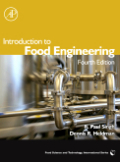
This fourth edition of this successful textbook succinctly presents the engineering concepts and unit operations used in food processing, in a unique blendof principles with applications. Depth of coverage is very high. The authors use their many years of teaching to present food engineering concepts in a logical progression that covers the standard course curriculum. Both are specialists in engineering and world-renowned. Chapters describe the application of a particular principle followed by the quantitative relationships that define the related processes, solved examples, and problems to test understanding. Why adopt this new edition? It features new chapters on - supplemental processes such as: Filtration; Sedimentation; Centrifugation; Mixing; Extrusion Processesfor Foods; Packaging Concepts; and, Shelf Life of Foods. It provides expandedinformation on: transport of granular foods and powders; process controls andmeasurements; emerging technologies such as high pressure and pulsed; electric field; design of plate heat exchangers; impact of fouling in heat transfer processes; use of dimensional analysis in solving problems; animated versions of figures on companion Web site. It presents extensive pedagogy including: examples throughout each chapter, presented in 'Given - Approach - Solution' format for clear presentation of key concepts; End of Chapter Problems to assess comprehension; List of Symbols; 'Advanced' level questions called out in a separate section; and, key equations highlighted. Information and animated versions of figures from text available on author Web site. Written to follow the typical Food Engineering course, making it easily adaptable for each classroom.
- ISBN: 978-0-12-370900-4
- Editorial: Elsevier
- Encuadernacion: Cartoné
- Páginas: 864
- Fecha Publicación: 01/12/2008
- Nº Volúmenes: 1
- Idioma: Inglés
